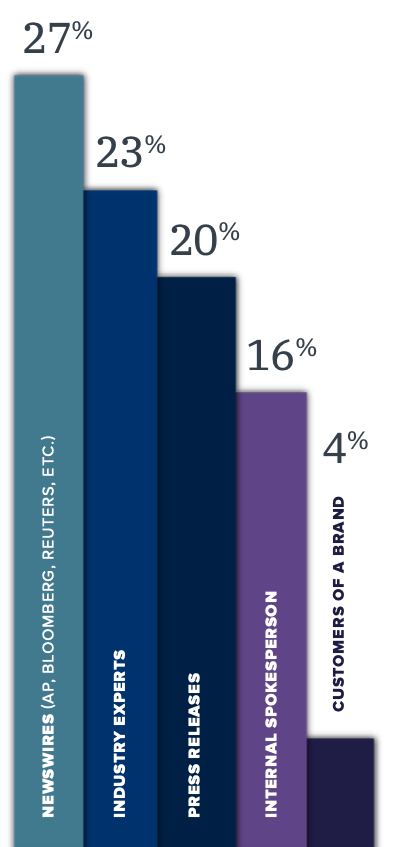Data to help you improve media relations: Cision’s State of Media
As PR professionals, we deeply care about our relationships with the media and journalists. One of the ways we keep up with developments is through research pieces like the Cision State of Media report. So here are our top picks and a few thoughts on how they can be used to become a key contact for journalists and not the spam that overflows their inbox!
Creating credibility – journalists feel the pressure to build trust
The findings reiterate and confirm issues most media relations experts will be aware of. The industry continues to struggle with declining ad revenue and a fast-paced world dominated by social media. On the individual level, journalists are feeling this trend in smaller teams that must keep up the previous story output. Here comes a finding that is a little surprising: journalists are not only mandated to write compelling stories that get clicks, they also need to further the brand image of their media company and they need to maintain and expand trust as a credible news source. Many cited maintaining credibility as the biggest challenge.
In an effort to remain a trusted news source and journalist, 58 percent cited accuracy across their reporting as one of their top priorities. Their biggest personal challenge is ‘keeping up’ with smaller teams. This trend is a natural consequence, seeing as data and fact-checking for accuracy is detailed work that requires a slowdown, while at the same time the pace of the information and media cycle has become more fast-pace. The good news is that PR professionals can provide valuable support to journalists in this position.

The power of data and third-party validation
In the quest for accuracy, data is a tried-and-true method for fact-based stories. Still, the uptake is staggering: compared to last year alone, 40 percent of journalists reported they are using data more often. Despite being savvy processors of information, most journalists have no access to statistical research. It naturally follows that 68 percent of journalists said they would gladly receive data in the form of original research, such as trends and market data from PR professionals.
Beyond data, journalists cited Newswires (AP, Bloomberg, PR Newswire, etc.), industry experts, press releases and internal spokespeople as their trusted sources. Contrastively, email pitches and company blogs were lowest on the list. So, while a trusted expert is a valuable source, pitches are still seen as too promotional. A way to make a pitch more credible and take it from a perceived intent to ‘sell’ to ‘inform’ is context and validation through third parties.
Though the report does not relay exactly what this looks like, we could imagine three exemplary scenarios:
- Looking to make a journalist aware of a trend and connect them with an expert? Prove the trend is there with third-party data AND spell out what makes your spokesperson an expert
- Advocating for a social issue? Share at least a few helpful original data points or unique voices and proof that the person or brand are invested in the case: show their advocacy outside of Pride Month and their support for professional development for minorities in their company or industry, for example
- Want a journalist to cover a product? Add reliable data that shows this product solves a relevant problem for their audience and the size of the problem
Thinking with a journalist: How to be a good contact
So, what do journalists want from media relations professionals? Simple: provide data and expert sources, say 66 percent – nearly two-thirds of journalists. Data is a little vague here, so understanding how exactly your key contacts are using data in their work is key. Do they need proof points to illustrate industry trends or are they using surveys as a core element to highlight issues or are they just looking to be specific? The more PR professionals are there providing the right information to key questions, the more they will be able to position themselves as indispensable and in-demand partners.

Figure 1: Question: What do you consider the most trustworthy for gathering/validating information?
Beyond delivering the right materials for journalists to work with, creating a good bond with journalists can mean supporting their work. Overall, journalists have a heavier reliance on social media primarily to promote their work and engage with their audiences. Unsurprisingly, with the Twitter (now X) turmoil. In fact, X is the platform journalists plan to decrease their usage the most (-20%), followed closely by Facebook (-18%). Instead, LinkedIn (+20%) is now the chosen platform journalists reported they plan to use more frequently.
This information should be taken with caution. Avoid pitching journalists on social media unless you know them personally and they have expressed a favourable view on this. In the grand scheme, only 4 percent of all journalists want to receive pitches via social media. The consequences for getting it wrong are more intense than a mismatched email pitch as 19 percent will actually block a comms professional for reaching out on social media unsolicited. Social media can be a powerful tool for connecting with journalists, particularly if you understand why they’re on there, what they post about, and amplify their work.
As communications professionals the nature of our relationship with media directly impacts our performance. At a time when the competition for attention is high, establishing a longstanding relationship is your best bet to thrive. The mantra put forth by Cision captures this perfectly: Moving from “thinking like a journalist” to “thinking with a journalist” is the new gold standard.



